
eBook - ePub
Introducing Time
A Graphic Guide
Craig Callender,Ralph Edney
This is a test
- 176 pages
- English
- ePUB (mobile friendly)
- Available on iOS & Android
eBook - ePub
Introducing Time
A Graphic Guide
Craig Callender,Ralph Edney
Book details
Book preview
Table of contents
Citations
About This Book
What is time? The 5th-century philosopher St Augustine famously said that he knew what time was, so long as no one asked him. Is time a fourth dimension similar to space or does it flow in some sense? And if it flows, does it make sense to say how fast? Does the future exist? Is time travel possible? Why does time seem to pass in only one direction?These questions and others are among the deepest and most subtle that one can ask, but Introducing Time presents them - many for the first time - in an easily accessible, lucid and engaging manner, wittily illustrated by Ralph Edney.
Frequently asked questions
How do I cancel my subscription?
Can/how do I download books?
At the moment all of our mobile-responsive ePub books are available to download via the app. Most of our PDFs are also available to download and we're working on making the final remaining ones downloadable now. Learn more here.
What is the difference between the pricing plans?
Both plans give you full access to the library and all of Perlego’s features. The only differences are the price and subscription period: With the annual plan you’ll save around 30% compared to 12 months on the monthly plan.
What is Perlego?
We are an online textbook subscription service, where you can get access to an entire online library for less than the price of a single book per month. With over 1 million books across 1000+ topics, we’ve got you covered! Learn more here.
Do you support text-to-speech?
Look out for the read-aloud symbol on your next book to see if you can listen to it. The read-aloud tool reads text aloud for you, highlighting the text as it is being read. You can pause it, speed it up and slow it down. Learn more here.
Is Introducing Time an online PDF/ePUB?
Yes, you can access Introducing Time by Craig Callender,Ralph Edney in PDF and/or ePUB format, as well as other popular books in Naturwissenschaften & Physik. We have over one million books available in our catalogue for you to explore.
Information
Topic
NaturwissenschaftenSubtopic
PhysikWhat is Time?
The great theologian and philosopher, St Augustine (AD 354-430), famously wrote of his puzzlement in The Confessions.
After pointing out all the things he is able to say about time without knowing what it is – for instance, that it takes time to say this – he admits that he really is in a “sorry state, for I do not even know what I do not know!”.
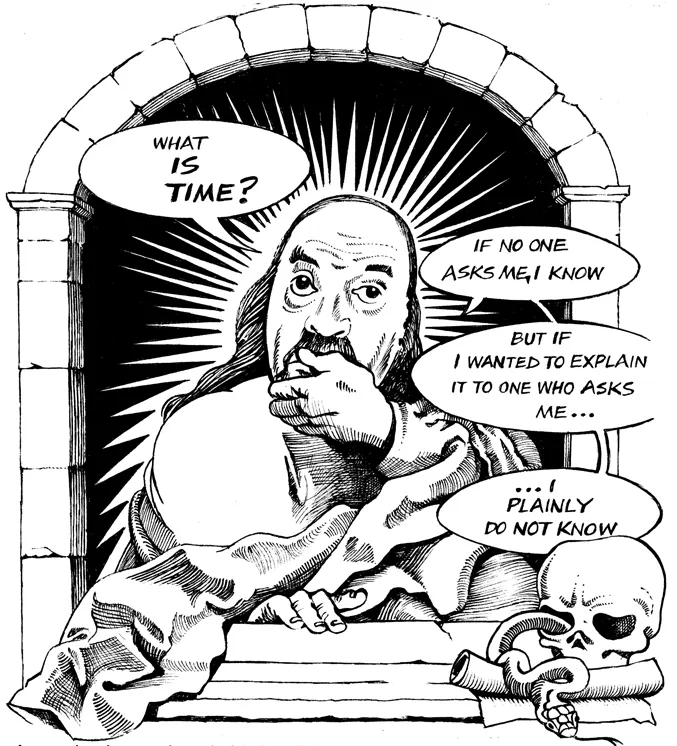
WHAT IS TIME? IF NO ONE ASKS ME, I KNOW BUT IF I WANTED TO EXPLAIN IT TO ONE WHO ASKS ME… … I PLAINLY DO NOT KNOW
Augustine is not alone in his bewilderment. The question of what time is and related puzzles – such as whether the past and future are real, whether time travel is possible, and the explanation of the direction of time – are among the most intractable yet fascinating questions asked.
All Kinds of Clocks
In everyday life, we are probably most familiar with time from two sources: clocks, and our inner psychological experience of time.
Clocks are everywhere. There are grandfather clocks, watches, alarm clocks, even incense clocks that let you tell the time through scent.
There are also natural clocks.

But clocks existed well before the modern invention of portable artificial ones.
Over four thousand years ago, the Egyptians used obelisk shadow clocks, sundials, and water clocks which measured time by the flow of water passing through a stone vessel.
By 1800 BC, the ancient Babylonians had divided the day into hours, the hour into sixty minutes, and the minute into sixty seconds.
All the great civilizations of the past used the positions of the sun or stars to tell the time.
These clocks were very accurate.
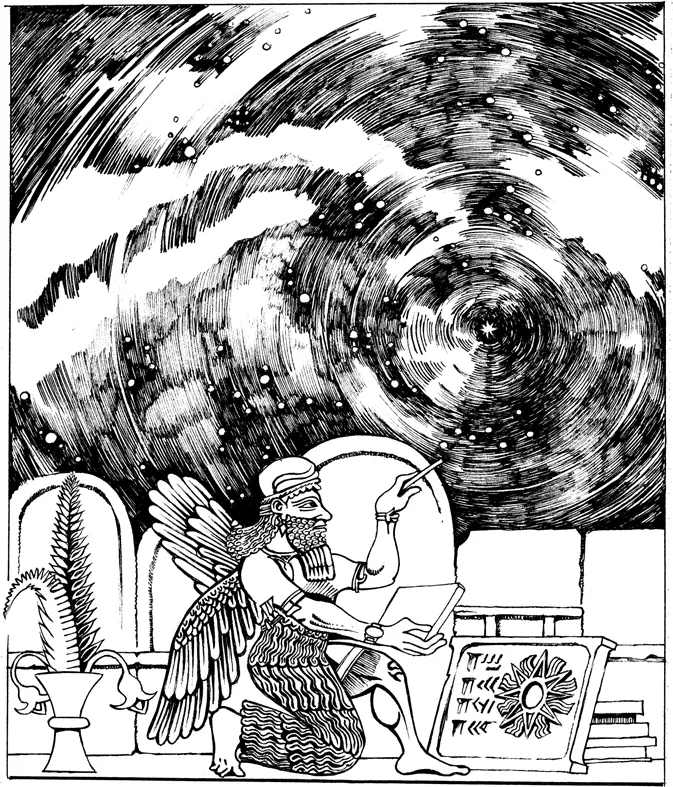
Looking at the stars with the naked eye, an ancient astronomer could tell the time to within fifteen minutes. And anyone can tell roughly the time merely by looking up at the sun.
Biological Clocks
We also carry within us our own biological clocks. The human heart beats 70 times on average each minute. Our moods, alertness, and appetites follow regular patterns, depending on the time of day, the lunar cycle or the season.
Our biological clock seems to be intimately associated with a group of nerve cells in our brain’s hypothalamus.
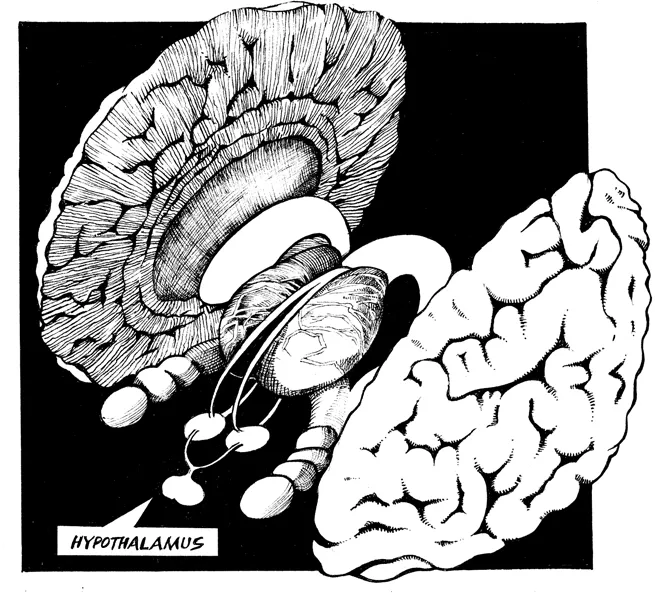
HYPOTHALAMUS
These cells are linked to the retina of our eyes and appear to regulate cycles of hormone secretion, our skin temperature and cycles of rest and wakefulness. The hormone melatonin is thought to play a significant role in controlling our daily (circadian) rhythm.
Biological clocks are not special to us. Every creature in nature seems to have them. Some are so good that they have been proposed for human use. The Swedish naturalist Carl Linnaeus (1707–78) thought we might use flowers as clocks.

Surprisingly, not every biological clock is based on the day, lunar cycle, season or year. The cicada is a remarkable chirping insect that remains underground for 17 years. Then 17 years after going underground, thousands of them emerge at the same time, climb the trees, mate and then die a few hours later, whereupon the 17-year cycle begins again.
Whether natural or artificial, clocks have helped order the patterns of life for as long as human beings have been around. In modern society, they also can cause a lot of stress.
Psychological Time
We also feel time pass. In addition to the physical time measured by various clocks, there is also psychological time. We have memories of the past and anticipations of the future. And we experience temporal durations of different sizes. We are personally, subjectively aware of time passing.
Everyone can guess roughly how much time has passed between two events.
Some people can do this surprisingly well, as if there were little inner clocks in our heads – related somehow to the biological clocks.

The interesting thing about these inner clocks is that they seem to speed up or slow down for a person in ways that disagree with other people’s inner clocks.
According to a watch, the trip on a super-fast roller coaster might take only 11 seconds.
11 seconds might seem an eternity to the person on the ride, whereas it may seem like almost nothing to someone waiting. A game of basketball might seem to pass in no time to the child playing it, but forever for the parent watching his twentieth such game in a month!

To begin our investigation into time, it’s important to see that time is more than merely clocks or the subjective experience of time. Time isn’t simply the alarm clock on your nightstand or something solely in your mind. Once we establish this, curious and deep questions will be right around the corner.
Is Time Merely in the Head?
After calming from his initial panic, Augustine argues that time doesn’t really exist outside the head.

WHEN WE MEASURE TIME WE MEASURE WHAT REMANINS FIXED IN MEMORY IT IS IN MY OWN MIND, THEN, THAT I MEASURE TIME. I MUST NOT ALLOW MY MIND TO INSIST THAT TIME IS SOMETHING OBJECTIVE
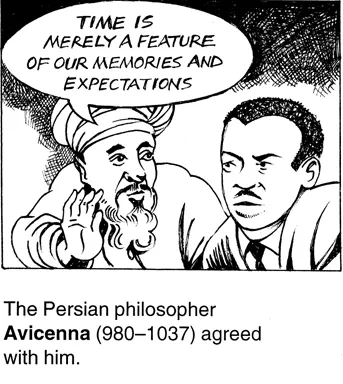
TIME IS MERELY A FEATURE OF OUR MEMORIES AND EXPECTATIONS
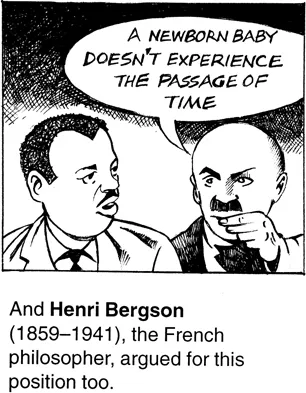
A NEWBORN BABY DOESN’T EXPERIENCE THE PASSAGE OF TIME
Can this be right? Although people disagree about their feelings of how much time has passed, they also enjoy remarkable agreement about the temporal ordering of events.
For example, the father and son returning home from the basketball game might not have looked at a clock since they left for the game – and maybe it was overcast, so they have no sense of where the sun is.
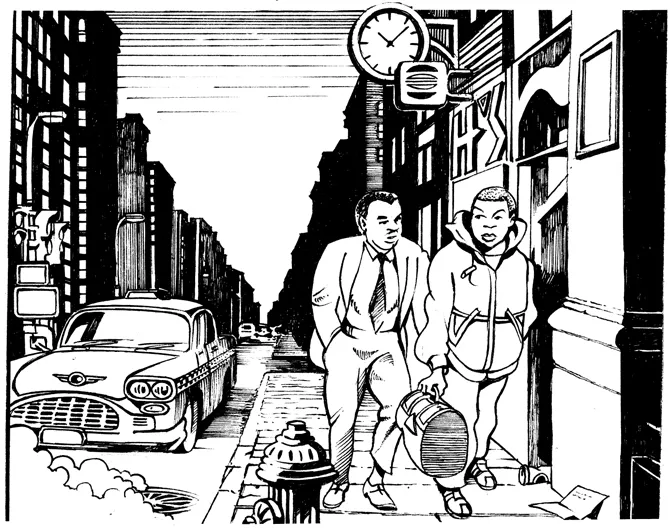
Suppose they guess what time it is before actually looking at a clock. Their guesses might disagree by as much as a couple of hours. They might even argue about who is right, but they typically won’t argue much about the ordering of events that took place.
“We agree that the free throws by Smith in the second half occurred sometime after his free throws in the first half…”
“And Joey broke his finger when Smith stepped on it. ”
Except in rare circumstances, everyone (who has the same information available) agrees – for the most part – on the time order of events. There is definitely something objective and independent of a particular person’s feelings about the time ordering. The objectivity of the ordering of events in time proves that there is more to time than just our psychological sense of its passage. There is the fact that events seem to be laid out in a unique and observer-independent succession in time.
Clocks and Time
Is this agreement merely agreement about what clocks will say? Maybe all there is to time is clocks. This is actually already a deep question. But, at least at first ...
Table of contents
- Cover
- Title Page
- Copyright
- Contents
- What is Time?
- Further Reading
- About the Authors
- Index
Citation styles for Introducing Time
APA 6 Citation
Callender, C., & Edney, R. (2014). Introducing Time ([edition unavailable]). Icon Books Ltd. Retrieved from https://www.perlego.com/book/569869/introducing-time-a-graphic-guide-pdf (Original work published 2014)
Chicago Citation
Callender, Craig, and Ralph Edney. (2014) 2014. Introducing Time. [Edition unavailable]. Icon Books Ltd. https://www.perlego.com/book/569869/introducing-time-a-graphic-guide-pdf.
Harvard Citation
Callender, C. and Edney, R. (2014) Introducing Time. [edition unavailable]. Icon Books Ltd. Available at: https://www.perlego.com/book/569869/introducing-time-a-graphic-guide-pdf (Accessed: 14 October 2022).
MLA 7 Citation
Callender, Craig, and Ralph Edney. Introducing Time. [edition unavailable]. Icon Books Ltd, 2014. Web. 14 Oct. 2022.